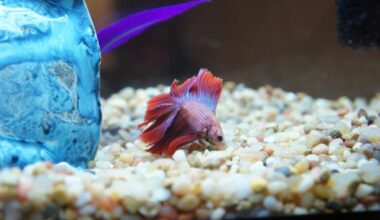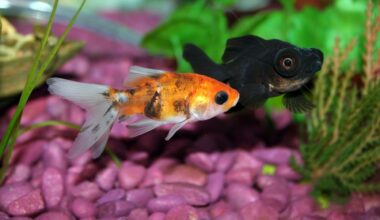Popeye is a fish disease you really want to avoid. It’s not only quite painful (and potentially dangerous) for your fish, but it’s a hassle to deal with as well!
But as an aquarist, it’s important to understand this disease and what you can do to keep your fish safe.
This resource will teach you popeye disease symptoms, causes, and treatment options. Being prepared is absolutely essential if you want to protect your tank.
Table of Contents
What Is Popeye Disease?
Popeye disease is a condition that causes the eye of a fish to bulge, swell up, or protrude from the socket. Scientifically, the disease is known as exophthalmia.
The bulging appearance of the eye is a result of fluid buildup. The fluid can accumulate behind the eye or within the eye itself (this all depends on the cause of the disease).
The severity of popeye can vary quite a bit. In more mild cases, the eye may stay clear and only have a moderate amount of swelling.
However, more serious instances of the disease can damage the cornea, creating a cloudy appearance. If not addressed, the swelling can get so bad that the eye will rupture and fall out.
To make matters worse, popeye is typically accompanied by other health issues. Opportunistic bacteria can take hold, resulting in severe infections. The same goes for fungal problems.
Popeye can affect all fish regardless of species or environment. It also affects both freshwater and saltwater fish.
Author Note: Sometimes, fish will only have popeye disease in one eye. These cases are unilateral. When both eyes are bulging, the condition is a case of bilateral popeye.
Symptoms
Symptoms of popeye disease in fish are subtle at first, so it can be difficult to catch the disease before it causes damage. Typically, the eye will only protrude a bit in the early stages. But in a matter of days, the swelling can balloon significantly and even affect the skin surrounding the eye.
In terms of behavioral changes, you might notice less activity. The fish may spend more time staying hidden. They might even show disinterest in food.
Is It Serious?
Popeye disease is a serious condition that requires immediate care. The sooner you’re able to provide treatment, the better the prognosis will be.
In most cases, the disease itself is not fatal. However, there are so many additional issues that could affect your fish. For example, your fish could lose their eyesight in one or both eyes.
Infected eyes can decay and fall out without treatment. In cases of unilateral popeye disease, fish can still recover after losing a single eye. But, their quality of life will be seriously affected. The potential care problems are only exacerbated if they lose both eyes.
You will have to make changes to help keep your fish healthy. Carnivorous or predatory fish will need time to adapt to the drastic change. Meanwhile, peaceful fish will be more vulnerable to attacks from others in the tank.
Beyond the issue of eyesight, you also have to worry about the effects of other infections. Popeye can quickly cause septicemia. This occurs when the infection moves into the bloodstream.
It’s a fatal infection. In most fatal cases of popeye, septicemia is to blame. It can cause organ failure throughout the body. Your fish may also succumb to parasitic infections and a host of other potentially dangerous problems.
Needless to say, popeye disease is a serious problem that you shouldn’t ignore!
Common Causes
There are a couple of potential causes you’ll need to consider. If your fish is suffering from unilateral popeye disease, a likely culprit is a physical injury.
Fish are injury-prone creatures. Skittish and highly active species are at a higher risk. Fish could accidentally bump into a rock and scrape their eye. Since they lack eyelids, fish are unable to provide last-second protection to their eye in these instances.
Your fish could have also gotten into a skirmish with another fish in the tank. Alternatively, you could have accidentally injured your fish with a net.
Whatever the case may be, the injury likely triggered a response from the immune system. This response is what causes the swelling.
Take a closer look at the eye to be sure. Oftentimes, you can see a scratch or physical sign of injury.
Another common cause is an internal infection. Fish that are suffering from other ailments often experience popeye. For example, kidney failure, Dropsy, or serious metabolic issues can cause fluid buildup.
One of the most common causes of popeye is poor water conditions. This is often the case with bilateral popeye.
Author Note: Interestingly enough, it’s not sudden drastic changes in water conditions that are going to put your fish at risk. Continual long-term exposure to poor water quality is what you have to worry about.
Popeye disease regularly causes trouble in overcrowded tanks or those that aren’t being maintained as they should. It’s believed that regular exposure to high ammonia and nitrate levels are to blame. Superstitious gases in unhygienic conditions are though to put fish at risk, too.
While you might only see one fish with popeye, others are at risk when conditions aren’t great. You’ll need to take swift action to ensure that the other fish don’t succumb to the disease as well.
Popeye Disease Treatment
Popeye disease treatment isn’t easy. Not only do you have to treat the underlying cause, but you also have to address potential bacterial infections.
Below are the steps we recommend for treating popeye disease:
1. Check The Water & Perform Changes
Start by checking the water conditions. If ammonia and nitrate levels are detectable, you need to make changes to address the problem as soon as possible. Also, check pH levels and temperature to ensure that the parameters are within the acceptable range for your fish.
To protect other fish in the tank, perform water changes to improve conditions. You might also consider doing a full deep clean to remove waste and keep ammonia levels in check.
2. Quarantine Infected Fish
In the meantime, it’s best to remove the infected fish. Place them in a separate quarantine tank with optimal water conditions.
3. Add Some Salt
To reduce swelling, you can treat the fish with Epsom salt. Add between one and three teaspoons of Epsom salt for every five gallons of water in the treatment tank.
This should help reduce swelling over the course of the next several days. As long as the water conditions are stable, corneal damage should heal as well. During the treatment, provide your fish with a balanced, vitamin-rich diet.
4. Deal With The Bacteria
Next, you’ll need to address bacterial problems. This is where things get tricky. You can use standard antibiotic and antibacterial products to prevent bacterial infections and cornea damage from worsening.
These are the types of products that are used to treat conditions like fin rot and infections. Typically, these products are applied directly into the water.
To address internal infections, you’ll need a broad-spectrum antibiotic. These usually come recommended by a vet and are administered orally. They come as food, making it easy to target the bacterial issues from within.
Treatment can take several months in serious cases of popeye. Continue to monitor your fish and the water conditions. Over time, the eyes should deflate and go back to normal.
For safekeeping, you may want to treat the main tank with antibiotics as well. If one fish was affected due to bad water conditions, the other fish in your aquarium are still at risk.
Improve water conditions and use an all-purpose antibiotic to be on the safe side!
Prevention Options
The best thing that you can do is take steps to prevent popeye from happening in the first place! Because this disease is caused by so many things, there’s no singular method to prevent it. You’ll have to be proactive and consider all potential causes.
Start by taking a look at your tank setup. If it’s overcrowded, consider upgrading to a larger tank or moving some of the fish out. Give your fish plenty of room to swim and breathe!
Larger tanks are always better. With larger tanks, waste problems are less likely because the volume of water easily dilutes toxic chemicals.
To prevent poor water conditions, check levels regularly. Perform 20-percent water changes every week and make sure that your filter is in good condition.
Ideally, ammonia and nitrate levels should be undetectable at all times. If the compounds are detectable at any point, your tank might still be overcrowded. Alternatively, your filter might not be performing as it should.
When you feed your fish, provide only enough food that they can eat in two minutes. If there are any remnants left over, remove them from the tank. This will preserve water quality and decrease the chances of your fish experiencing popeye.
Finally, you can modify the decor in your tank to prevent accidental injuries. Get rid of any sharp edges or abrasive rocks. Some rocks and driftwood are necessary. But they should be relatively rounded and safe for all fish in the tank.
Author Note: You might also want to rethink how you interact with your fish! Ditch any scratchy nets and be a bit gentler when cleaning or moving decorative items.
Preventing popeye disease is pretty easy. Just adopt good care habits and keep an eye on your fish. If you notice any issues with dangerous items or water parameters, take the necessary steps to keep your fish safe, healthy, and happy.
Closing Thoughts
Popeye disease in fish is no fun. It’s dangerous, painful, and hard to fight.
But that doesn’t mean there’s nothing you can do.
As you can see, there are plenty of options for diagnosing, treating, and preventing popeye disease in your tank. Be consistent with the effort you put into protecting your fish, and they’ll thrive as a result!

